#european war 7: medieval
Text
Baldwin IV, the... Gamer King?
Something I've found interesting - and rather surprising, tbh - is the increasing number of games and game concepts in which Baldwin IV features, and not simply as inspiration for the characters' designs, but as himself.
Here's how many places I've found him and the accompanying artwork of him (all very obviously inspired by - you guessed it - Kingdom of Heaven)
==================
First, the actual games...
1) Evony: The King's Return
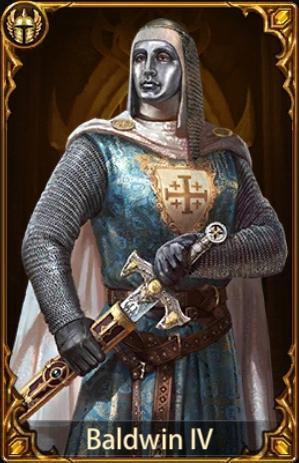
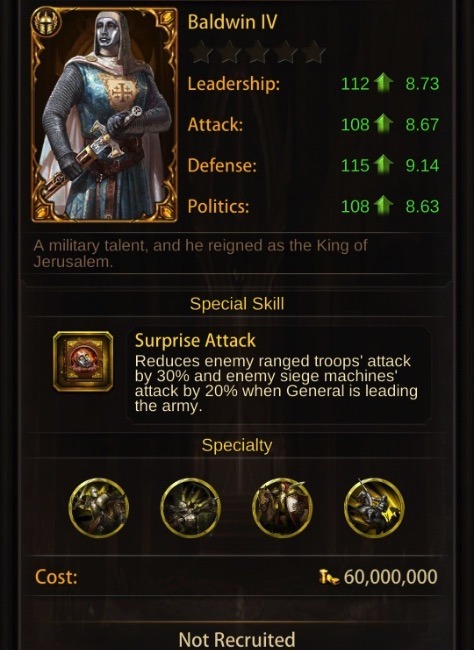

This article from One Chilled Gamer gives the details on his statistics.
2) Blood of Steel

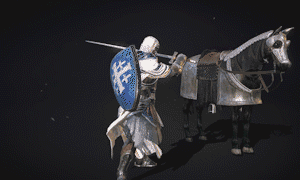
You can find the details in this news announcement on the game's Steam hub.
3) European War 7: Medieval

It's a little harder to find information on this one, but there's a discussion thread here on him.
==================
Baldwin also makes an appearance in the mods for several games, including...
Sid Meier's Civilization V
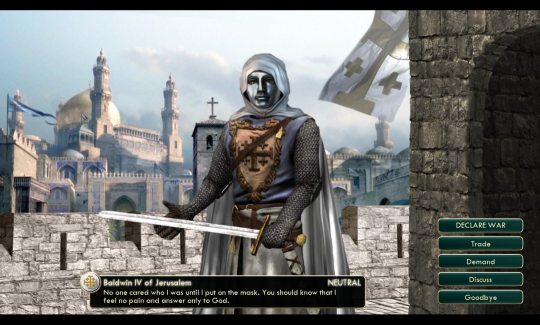
This mod adds the Kingdom of Jerusalem as a civilization to the game, with Baldwin IV as its leader. There's info on him on this wiki page, including his war and peace themes ("The Holy Land" and "Siege of Kerak" from Crusader Kings 2, respectively.)
Sid Meier's Civilization VI
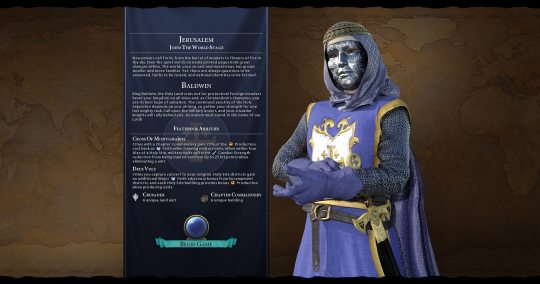
This mod also adds the Kingdom of Jerusalem into the next game of the series, again with Baldwin IV as its leader.
Crusader Kings III

This mod overhauls CK3 to allow the player to assume the role of any leader present in Kingdom of Heaven (as well as their contemporaries around Europe and Asia), including Baldwin IV - although you won't get to play as him for very long before his death.
==================
Finally, I've found some concept-style art of Baldwin floating around out there, too, although I'm not certain they are for an actual game or simply intended for a potential game if they happen to grab a developer's interest.
This one is by ShawnFox on Artstation:

And this one is by XuanHan Chen, also on Artstation:
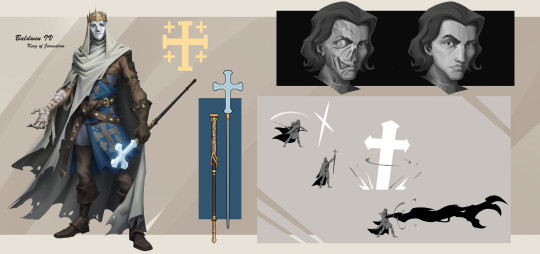
==================
This is all I've personally been able to find so far, but there's probably more out there I've missed. If anyone has run across any other game-related art of Baldwin IV, please share!
#baldwin iv#king baldwin iv#kingdom of heaven#the leper king#kingdom of heaven 2005#baldwin iv of jerusalem#kingdom of heaven fandom#gaming art#concept art#official artwork#mods#evony#blood of steel#european war 7: medieval#civilization 5#civilization 6#crusader kings 3#shawnfox#xuanhan chen
105 notes
·
View notes
Note
OKAY so rangers apprentice is this book series set in medieval europe-adjacent, like it has countries clearly inspired by european regions and the names are usually related to the real world name, so that combined with the locations is not hard to figure out which countries are which
the main character is this 15 year old kid named Will who grows up throughout the series (11 books), and he’s the ranger’s apprentice in question. the Rangers are this ultra-secret group of spy archers who work for the king and a lot of ppl think they’re dark wizards but they’re actually just good at camouflage, so Will is apprenticed to one of the rangers and he ends up saving the country a couple times.
there’s not much of an overarching plot through the whole series but there are smaller arcs that go through a couple books, like books 1-4 are mostly together and then 5-6 could have been one long book, book 7 is a weird outlier that takes place between 4 and 5, and so on.
what’s interesting about the setting tho is that there’s not explicitly magic systems/users, but it’s heavily implied that there’s more to the world than meets the eye (i think there’s demons in a spin-off series? idk haven’t read that one yet) it’s sooooo fun
and the characters are super engaging too!!! there’s Will, the protagnist; Halt, his mentor; Horace, his best friend; Alyss the love interest; and lots more side characters that are interesting too and even tho i described them as how they relate to Will, they all get super interesting development and backstory. this got so long i’m sorry but rangers apprentice is one of the best book series i’ve ever read and i highly recommend it :33
Finally archers getting the attention and spotlight they deserve! (can you tell I’m partial??)
It’s really interesting (in a good way) that there’s a “lack” of over-arching plot. a lot of longer “media” i’ve “consumed” (at least lately) has suffered from a sort of burn-out where the stakes feel wonky and over done, yet underwhelming after going on for so long; it’s often affected other stuff like continuity and character development and consistency (hello supernatural, how goes the Winchester self sacrifice reset?). I’m actually really excited to see how smaller chunks over longer time will feel after so long.
I also love the idea of a magic system not being explicitly stated wether it’s it a star wars-y “long time ago in a galaxy far far away” type thing were it’s implied that you’re reading an in universe recollection where you’re already supposed to “know” or it’s a narrative tool for the author to frame perspective/plot twists etc
I’m gonna go now and start looking for epubs and shit even though my kindles broke :,( (fuck you ryaniar) and i’m looking for a new one
#also side note is anybody else’s ask box broken? like mines been saying i have exactly one ask constantly for the past like 9 months#but it didn’t tell me you dropped this in my ask box??#marty 📼#rangers apprentice
31 notes
·
View notes
Text
Online History Short-Courses offered by Universities Masterpost
Categories: Classical Studies, Egyptology, Medieval, Renaissance, The Americas, Asia, Other, Linguistics, Archaeology
How to get Coursera courses for free: There are several types of courses on Coursera, some will allow you to study the full course and only charge for the optional-certificate, for others you will need to audit it and you may have limited access (usually just to assignments), and thirdly some courses charge a monthly subscription in this case a 7 day free trial is available.
Classical Studies 🏛️🏺
At the Origins of the Mediterranean Civilization: Archeology of the City from the Levant to the West 3rd-1st millennium BC - Sapienza University of Rome
Greek and Roman Mythology - University of Pennsylvania
Health and Wellbeing in the Ancient World - Open University
Roman Architecture - Yale
Roman Art and Archeology - University of Arizona
Rome: A Virtual Tour of the Ancient City - University of Reading
The Ancient Greeks - Wesleyan University
The Changing Landscape of Ancient Rome. Archeology and History of Palatine Hill - Sapienza University of Rome
Uncovering Roman Britain in Old Museum Collections - University of Reading
Egyptology 𓂀⚱️
Egypt before and after pharaohs - Sapienza University of Rome
Introduction to Ancient Egypt and Its Civilization - University of Pennsylvania
Wonders of Ancient Egypt - University of Pennsylvania
Medieval 🗡️🏰
Age of Cathedrals - Yale
Coexistence in Medieval Spain: Jews, Christians, and Muslims - University of Colorado
Deciphering Secrets: The Illuminated Manuscripts of Medieval Europe - University of Colorado
Enlightening the Dark Ages: Early Medieval Archaeology in Italy - University of Padova
Lancaster Castle and Northern English History: The View from the Stronghold - Lancaster University
Magic in the Middle Ages - University of Barcelona
Old Norse Mythology in the Sources - University of Colorado Bolder
Preserving Norwegian Stave Churches - Norwegian University of Science and Technology
The Book of Kells: Exploring an Irish Medieval Masterpiece - Trinity College Dublin
The Cosmopolitan Medival Arabic World - University of Leiden
Renaissance ⚜️🃏
Black Tudors: The Untold Story
European Empires: An Introduction, 1400–1522 - University of Newcastle
The Mediterranean, a Space of Exchange (from Renaissance to Enlightenment) - University of Barcelona
The Life and Afterlife of Mary Queen of Scots - University of Glasgow
The Tudors - University of Roehampton London
The Americas 🪶🦙🛖
History of Slavery in the British Caribbean - University of Glasgow
Indigeneity as a Global Concept - University of Newcastle
Indigenous Canada - University of Alberta
Indigenous Religions & Ecology - Yale
Asia 🏯🛕
Contemporary India - University of Melbourne
Introduction to Korean Philosophy - Sung Kyun Kwan University
Japanese Culture Through Rare Books - University of Keio
Sino-Japanese Interactions Through Rare Books - University of Keio
The History and Culture of Chinese Silk - University for the Creative Arts
Travelling Books: History in Europe and Japan - University of Keio
Other
A Global History of Sex and Gender: Bodies and Power in the Modern World - University of Glasgow
A History of Royal Fashion - University of Glasgow
Anarchy in the UK: A History of Punk from 1976-78 - University of Reading
Biodiversity, Guardianship, and the Natural History of New Zealand: A Museum Perspective - Te Papa
Empire: the Controversies of British Imperialism - University of Exeter
Great South Land: Introducing Australian History - University of Newcastle
Indigeneity as a Global Concept - University of Newcastle
New Zealand History, Culture and Conflict: A Museum Perspective - Te Papa
Organising an Empire: The Assyrian Way - LMU Munich
Plagues, Witches, and War: The Worlds of Historical Fiction - University of Virginia
Russian History: from Lenin to Putin - University of California Santa Cruz
Linguistics 🗣️
Introduction to Comparative Indo-European Linguistics - University of Leiden - Coursera version
Miracles of Human Language: An Introduction to Linguistics - University of Leiden
Archeology 💀
Archeoastronomy - University of Milan
Archaeology and the Battle of Dunbar 1650 - Durham University
Archaeology: from Dig to Lab and Beyond - University of Reading
Archeology: Recovering the Humankind's Past and Saving the Universal Heritage - Sapienza University of Rome
Change of Era: The Origins of Christian Culture through the Lens of Archaeology - University of Padova
Endangered Archaeology: Using Remote Sensing to Protect Cultural Heritage - Universities of Durham, Leicester & Oxford
Enlightening the Dark Ages: Early Medieval Archaeology in Italy - University of Padova
Exploring Stone Age Archaeology: The Mysteries of Star Carr - University of York
Forensic Archaeology and Anthropology - Durham University
Roman Art and Archeology - University of Arizona
The Changing Landscape of Ancient Rome. Archeology and History of Palatine Hill - Sapienza University of Rome
#side note: most of the universities that offer courses in English on these sites are European or American(USA)#so the lack of courses about Asia (other than Japan) The Americas and Africa is not because of me#history#historical#classical studies#ancient Greece#ancient Rome#pompeii#Egyptology#pharaoh#ancient Egypt#medieval#medieval europe#Medieval Arabia#Renaissance#Tudor#the tudors#history courses#courses#linguistics#archeology#archeology courses#resources#free resources
161 notes
·
View notes
Text

Nearly 8,000 Medieval Coins and 7 Bronze Age Swords Unearthed in Germany
Volunteer archaeologists found bronze age seven swords and from the 11th century 6000 silver coins in the northeastern German state of Mecklenburg-Vorpommern.
Volunteer archaeological conservationists were searching an area in Mecklenburg-Western Pomerania when they found the metal fragments, the Mecklenburg-Vorpommern Ministry of Science, Culture, Federal and European Affairs said in a Nov. 22 news release.
The seven swords were found in fragments near Mirow (Mecklenburg Lake District). Scientific dating has shown that the swords date back to the Bronze Age. Their age is estimated at around 3,000 years.
Archaeologists reassembled the fragments into seven swords, the release said. A photo shared on Facebook by the ministry shows the ancient weapons.

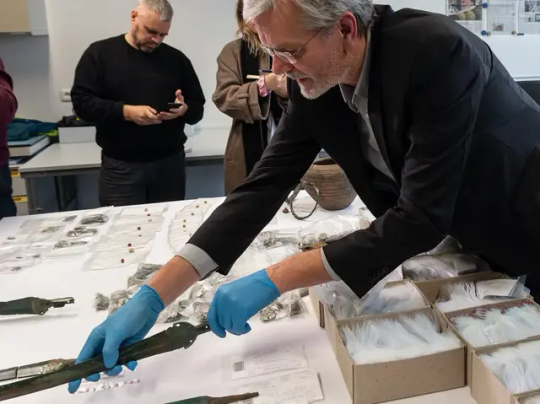
The swords were likely left in the lowland area as a ritual or sacrificial offering, officials said. Although such deposits of valuable items are not unusual, so many Bronze Age swords have never been discovered in one place in Mecklenburg-Western Pomerania.
The seven swords were found in fragments near Mirow (Mecklenburg Lake District). It can be assumed that they came to the surface some time ago when a trench was being dredged and was spread over a larger area with the dredged material. The finders meticulously tracked down the individual fragments, making it possible to put the swords back together almost completely. The recovery was carried out together with an excavation technician from the state archaeology department.
According to the release, volunteers also discovered two other sets of finds, both from the 11th century, in different areas of Mecklenburg-Vorpommern.
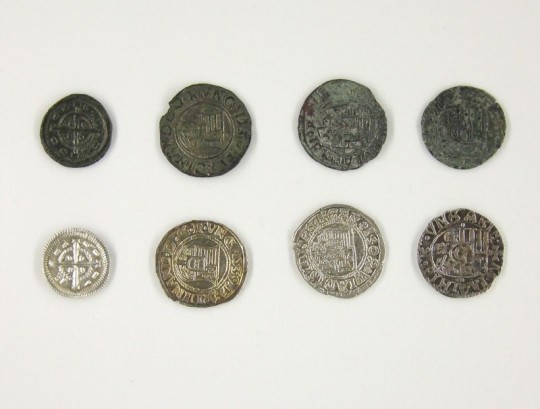
A collection of 6,000 silver coins was unearthed in Rügen, officials said. The find is the largest Slavic coin hoard of the post-war period to date.
The coins were mostly found in a clay pot, but some were spread out nearby. The coins came from a variety of places including western Germany, England, Denmark, Hungary and modern-day Czechia, the release said.
Archaeologists said the variety reflects trade relationships from the 11th century.
Volunteers in the Mecklenburg Lake District also found 900-year-old reliquary containers used to hold religious items. In a pot with around 1,700 coins were neck and finger rings, a pearl necklace (with gold, rock crystal, and carnelian beads), and two reliquary containers that could be interpreted as evidence of the Christian faith. This, in turn, was unusual in an area that was still largely characterized by different beliefs at the time, it was said.
By Leman Altuntaş.


#Nearly 8000 Medieval Coins and 7 Bronze Age Swords Unearthed in Germany#Mecklenburg-Vorpommern#silver coins#collectable coins#silver jewelry#Bronze Age swords#ancient artifacts#archeology#archeolgst#history#history news#ancient history#ancient culture#ancient civilizations#bronze age#middle ages
26 notes
·
View notes
Text
Random rambling thoughts on ✨WISH✨ before the movie comes out
- This movie is for the sleeping beauty girlies… or at least IT HAS TO BE. Any other vibe and I’m gonna be extremely disappointed. It’s already giving medieval European fairytale with gorgeous animation so they can’t fumble this bag. I’m not really sure yet what I expect from the plot but I just need a sleeping beauty energy to it idk idk. I don’t really know what I mean by it cause sleeping beauty is so contradictory in itself, it’s so epic but also so quiet and calm and simple… we’ll see
- This movie is gonna comment on astrology and the horoscope right right??? You cannot do a movie about wishes and stars and not give us a peak into the starry night the characters look upon to and study! If I don’t have a scene of asha discussing constellations then what’s the point 😒 but like even just the aesthetics in the background or something. I need it
- I know everyone knows this movie is set in Spain but the official sources say Iberian peninsula and u bet your ass that, as a portuguese gal, imma remind y’all about it cause we get so little representation while the Spanish get everything well now they’ll have to share 😭😭😭😭😭
- Asha having friends is so anti Disney princess of her 😭😭😭 those other girls only talk to animals. Tiana and Pocahontas are the only girls with a bff and that’s only 1, Asha has 7 😭😭😭 I’m not very impressed with their designs but I guess they can grow on me
- I’m guessing the movie is entirely in the kingdom and it’s nearby places like tangled and sleeping beauty, as opposed to movies like moana or frozen that force them out of their home in a long journey
- Do u guys think the Easter eggs will be subtle or Ralph breaks the internet kind of in your face? Cause disney is making a lot of promises, dozens of Easter eggs right? But I think the in your face crossover will be just for the once upon a studio short, and in the movie the cameos will be more Easter eggs and subtle. (Out of topic but have y’all seen that Lego trailer for the Disney princesses vs Gaston thing? I’m telling y’all rn, disney in gonna give up an official disney animation studios movie of the princesses all together in an adventure before 2040!! IM JUST SAYING!)
- I hope the musical numbers take notes from encanto in the dynamism of we don’t talk about Bruno and dreamlike sequences from surface pressure. I just don’t love when characters are forced to be stuck in reality, it feels very limited. Animation is supposed to break those restrictions. And like, not every musical number has to be like this, but I just want more than a character singing in point A, B and C u know? And I like how, for example, a character would start singing the song and then the 2nd half is a montage? Or like in when will my life begin where she starts singing, but then it’s all montage and she just sings again at the end. (Uncharted waters was a very good song with a very boring scene let’s be honest, and something like that is criminal but it would be even worse in animation)
- I’m really not sure what to expect from the plot and I haven’t really thought a]much about it but rn, if I had to guess, I’d say the movie is about a kingdom that parallels present day USA kkkk hear me out!!! The kingdom had low days of war but fought for independence and began from scratch. This family has magic and can grant people’s wishes and promises the people the equivalent of the American dream. But as generations pass, the king starts collecting more and more wishes without ever intending to grant them to the people or maybe the price of the wishes keeps getting higher. The "American" dream doesn’t exist anymore but people still believe in it cause they are powerless but hopefull. Basically the movie is gonna be about dethroning a tyrant and dismantling capitalism 😃 (look I’m not good with words or brain power but I think u understand what I mean). Maybe the king’s magic is fake, he just knows how to work with the stars own magic while no one else can. And in the end, Asha and her friends are gonna Robin Hood their way into granting the peoples wishes or just make then see that wishing only goes so far as you’re willing to work for your dream??… but like I’m serious, I really think this movie is gonna be a shade to America and is gonna go against everything bob iger represents
#disney#disney wish#wish#wish 2023#Asha#disney Asha#Asha disney#disney animation#wish disney#2023 wish#Asha wish#wish Asha
34 notes
·
View notes
Note
new here but am wondering what your current WIP is about? if you don't feel comfortable I understand!! love your blog btw <3
Omg thank you so much!!
My main WIP right now is WIPVII (placeholder name until I am forced to actually name it).
It is a lower YA (for 13-15 year olds) low/no magic fantasy (takes place in a different world) with a romance subplot.
It's a (high/late) medieval western European-inspired setting, specifically the year 1333 CE in southern England - I try to be somewhat historically accurate because it makes the setting feel a little fresher than leaning on the medieval European stereotypes common to a lot of fantasy. But alas, there is only so much research I am willing to do (and I did take some liberties because, dammit I wanted a masquerade ball).
The WIP draws inspiration from Shakespeare comedies (Cymbeline, Twelfth Night, The Tempest etc), Alfred Tennyson poems (in particular "The Splendour Falls"), the Robin Hood myth, and fairy tales and medieval epics in general.
[More below the cut]
The blurb:
Two kingdoms long at war have laid down their arms at last, but peace hinges on treaty that can only be sealed by the marriage of the eldest son of the King of Dian to the eldest daughter of the King of Cithidy. But Isolda de Angenet, the princess of Cithidy, has gone missing and she does not want to be found.
In disguise as a peasant boy, Isolde (known as Aldus) accidentally falls in with a ragtag group of bandits - and Henry, a knight with a mysterious past - who have been sent to find the missing princess and deliver her to the outlaw lord Hob. But there is some larger scheme afoot here.
Once more, a Cithian army marches reluctantly toward Dian and Isolde fears the only way to stop it is to return to her old life and join the husband she has never met in Dian. Isolde has forsworn this marriage but unless she can find another way, she fears she will have to choose between her own freedom and peace.
In the meantime, Henry is hiding something and Isolde will find out the truth, hopefully before Henry finds out who she really is.
Some other things about this WIP:
The name: WIPVII is just WIP + the roman numeral for 7 (VII). I refuse to properly name this WIP until I am forced to, so WIPVII is a placeholder name. I have a lot of WIPs so I number them from oldest to newest to keep track of them (this has nothing to do with the order I choose to work on them). This also means, when a WIP doesn't have a name yet, I have a convenient placeholder name ready to go! WIPVII is 7 because it is the 7th WIP I thought up.
Status: I am currently 60% of the way through my 3rd draft.
Word count: draft 2 was 77k and I am expecting draft 3 to be similar (around 82k because I added some description and worldbuilding and the prose is more flowery). I am aiming for 80k, give or take 5k.
WIPVII is meant to be a standalone.
--
The was inspired by the premise:
A princess runs away from an arranged marriage and ends up falling in love with the person she was supposed to marry (neither of them know who the other really is).
-- this is technically a spoiler, but they way the story is written I think most readers will guess the twist looong before it comes. And honestly, I think the story is a lot more fun if you figure it out well in advance. I am a sucker for dramatic irony.
4 notes
·
View notes
Text
Meta Masterpost
A Meta of Ice & Fire (A Song of Ice & Fire)
Why Ned would execute Theon
Bully Theon? Canon vs. Fanon
Westerosi and Medieval European Hostages: A Comparison
Comparing Robb's book & show love interests
Essays on a Galaxy Far Far Away (Star Wars)
Are the Jedi a Cult?
First Order & Jedi Order training. How similar is it?
Jedi & First Order Recruitment and the Effects of Child Separation
Mechanics and Ethics of the Jedi Mind Trick
Force Sensitive Jar Jar Binks
Obi-Wan is a Terrible Mentor
Skywalkers Ruin Everything?
How democratic was the PT-era GFFA?
The Dictator's Playbook
Vice-Admiral Holdo and the Importance of Costuming
What's on the HoloNet?
Agriculture on Tatooine
Howling in the Dark: Teen Wolf Meta (Teen Wolf (TV)
1) Scott McCall's evolving relationship with murder
2) Scott and Stiles aren't as close as you think
3) Scott's a True Alpha but WTF does that even mean?
4) No one believed Stiles long before they stopped believing in him.
5) Thoughts on the McCall family divorce and it's impact on Scott's character
6) The parentification of Stiles Stilinski
7) Allison and her heroine's journey
Cobra Kai
Sid Weinberg, Eli Moskowitz and the problem of Jewish masculinity
Julie and the Phantoms
Worldbuilding in the Real World
The Umbrella Academy
Diego Hargreeves and the Police Academy
#meta#a song of ice and fire#star wars#teen wolf#cobra kai#julie and the phantoms#the umbrella academy
7 notes
·
View notes
Note
Spinning off from my question about Grima's favorite and least favorite foods, what about sweets? What sorts of pastries or candies do you think could be found in Rohan, and which ones do you think Grima likes best?
Oh man! Love me some food talk! Especially Grima food talk :D Thank you for dropping this into my inbox~~
As usual, this got hecka long. (This is what happens when I answer on my desktop and not my phone.)
I love food and food history – it’s something I’m super keen on and love nattering on about, particularly as it relates to the medieval and early modern period. Though, for Rohan, we’re really talking late antiquity and early medieval in terms of time but ingredients in European cooking didn’t take a dynamic change until 1492 and the colonization of the Americas began.
I have a lot of thoughts about what Middle Earth has access to in terms of food products from the Americas – because clearly they got tobacco somehow. Also, apparently, tomatoes? And potatoes. Etc. (I know Tolkien has an answer to this but I’m still a little hmmmm/consistency check needed Tolkien about it.)
My answer will generally work based on the assumption that Rohan has limited to no access to ingredients that are wholly and entirely native to the Americas. Because, as we know, Tolkien intended Rohan to be reminiscent of Anglo-Saxon England and early medieval Scandinavia so I tried to work at least vaguely within those parameters. (I know he was like: it’s Mercia! But I refuse to be hampered by a single kingdom that ranged from 6th to the 9th century because Tolkien didn’t limit himself either.)
my tl;dr is: Grima has a sweet-tooth and loves carbs and dairy products so he's all about them honey cakes and sweet cheese tarts.
----
Frist off - base ingredients that the average Rohirrim would be working with as sweeteners are honey, fruits, nuts (e.g., chestnuts, walnuts, almonds), herbs/spices, syrups/confits (fruit or cereal based – strawberry, for example) and cheeses/dairy products.
Pending Rohan’s climate and geography, they might have the correct maple trees for syrup tapping (i.e., sugar maple, red maple, and black maple), which would add an additional flavouring agent to their dessert foods. But I personally find that doubtful. The temperatures in spring need to range from -4 at night to around 6 or 7 in the day for a proper sugar tap and I don’t see Rohan getting that cold consistently enough to make it work.
-
For the wealthy, there might be access to sugarcane products (i.e., sugar, molasses, rum ;) etc.), but I just can’t get my head around Middle Earth having sugarcane. If they did, it’d be in lands controlled by Sauron so access would be limited during times of war. Therefore, Grima growing up would likely not have seen any white or brown sugar, if it existed.
Other things that would have been accessible more to the rich in Rohan than anyone else: cinnamon, cloves, allspice, cardamom, ginger, vanilla and other herbs, spices etc. that grow outside Rohan – and in regions, coincidentally, mostly controlled by Sauron and/or have rough trade relations with allies of Gondor.
As this is the case, most of the sweetening Grima would be familiar with would come from honey and fruit. His palate, like most in a late-antiquity and early medieval society, probably ran towards sour and tart. Our palates today, especially in the west, are incredibly sweet in comparison to what our ancestors were used to.
All fermenting was done with wild yeasts and that tends to give you more sour flavour profiles in your ales/beers, meads, and yogurts than the controlled approach to brewing and dairy products we have today. Meat and fish were often preserved via salting, vinegar, or with the sour dairy run-offs from the cheese and yogurt process.
-
All this said! Some deserts or sweet snacks Grima would likely be familiar with include, but are not limited to:
Sweet breads (e.g., gingerbread [for the wealthy, in 14th c England a pound of ginger cost the same as a sheep], apple loaf, honey load, nut bread etc.)
Fried breads (think beignets or zeppoli, but also proto-funnel cakes)
Fried, baked or stewed fruits
Sweet cheeses
Custards
Skyr/something similar
Honey
Candied fruits and nuts
Tarts and pies (a very wide range of tarts and pies existed)
Cakes (and there are a wide range of these, too, e.g., I’ve seen an early medieval cheesecake recipe)
Cookies or sweet biscuits
Fried figure-of-eight snacks (an early medieval pretzel, basically)
Fritters (so many fritters, so little time)
Sweet toasts i.e. toastee (most usually topped with spiced honey and available nuts)
-
For Grima – I firmly believe the man has a devil of a sweet-tooth and therefore likes any and all things put in front of him that are vaguely sweet in nature.
He’d have grown up on simpler versions of everything listed above – a lot of honey, orchard fruits (e.g., apple, pear, cherry, plum, quinces, medlars) and local berry flavourings (e.g., blackberry, blueberry, strawberry, raspberry, gooseberry, lindenberry). Maybe nuts, depending on what was available. The herbs would have been rosemary, mint, elderflower, heather (get hiiiiigh), lavender (maybe), rose (for special occasions most likely), marjoram etc. Not sure his family would have had the income to access things like citrus of any kind, cinnamon, ginger etc.
Therefore, day to day when he was young it’d have been honey cakes and seed loafs and sweet cheeses and skyr + fruit (not unlike how we eat it today) and fruit or nut tarts etc.
-
When he entered Theoden’s household and was able to sit at the high table with the king’s family and chief advisors this is when he’d get the glories of cinnamon bread and candied ginger and lemon tarts and the like. Pineapples.
Grima: We can’t EAT the pineapple. We have to leave it on the table so people know we can afford it.
Eomer: We have more than one pineapple. We can eat it and display it.
Grima: M O R E. T H A N. O N E??
-
Personally, I think Grima just loves carbs. So he’s the one sharking all the sweet and fried bread products at the table. I think he also likes sweet cheeses and custards so is really happy whenever something is fried bread on the outside and a sweet cheese or something on the inside.
As palates ran tart/sour, I can see Grima enjoying Rohan’s answer to skyr straight with no additions to it. Same for sour cheeses served at the end of the meal.
If I had to rank Grima’s favourite deserts/treats, once he was part of Theoden’s household and can afford/has access to Fancy Things, I think it’d go:
Fried bread with cinnamon (i.e., Rohan-beignets)
Orange infused custard
Saffron custard tart
Honey cakes – preferably with cinnamon or vanilla
Skyr
Candied ginger and almonds
Gingerbread
Sweet cheese filled tarts (Rohan’s answer to the Danish)
Pear or apple fritters
That said, I can see him still enjoying throwbacks to the less fancy sweets of his childhood, such as the fritters, but also the more herbal and earthy flavourings that were available to his family—winter savory, lemon thyme, bay, lavender, mint, borage, rosemary, marigold, sweet marjoram etc.
-
I didn't get into sweet beverages (herbal wines, mulled anything, mead, flavoured ales, fruit wines etc.) because that's a whole other thing.
I hope this was helpful! These are many, many thoughts and honestly, I could probably have gone on for another three pages but I thought I should wrap it up.
Thank you so, so much for the ask! It made day :D :D
#lotr#lord of the rings#ask#reply#rohan#lotr meta#grima wormtongue#anon#food history#middle earth#grima thoughts#grima and food
15 notes
·
View notes
Text
Dracula’s Family History
Dracula’s speech from the May 8 entry where he talks about his family’s history was, in my opinion, extremely hard to understand. But I wanted to know what he said because my good friend Johnathan Harker seemed to think it was really neat, so I asked a friend to make a plain text translation for me. He obliged, but warned me that there were so many references in it, he’d need to make footnotes. He also asked me to make it clear to Tumblr that he does not have a degree in Medieval European history or anything, he just played a lot of Crusader Kings.
I’ve included the full translation below because I can’t be the only one who found the Count’s syntax absolutely impenetrable. I’ve also included the footnotes below the Read More. Everything within the body of the text is part of the translation except the bits in brackets. Those are either translator’s notes or, if they’re just numbers, references to the corresponding footnote.
“We Szekelys have a right to be proud, because we’re descended from many brave people who were great warriors. Here, in the whirlpool of European races [think ‘melting pot’, but edgier], the Norse Vikings brought with them from Iceland the fighting spirit they got from the Norse gods [1]. Their Berserker warriors displayed this fighting spirit and ravaged all the coasts of Europe, Asia, and Africa. They were so scary people thought they were really werewolves [2]. When the Vikings came here, they found the Huns, who were also very warlike and scary and did a bunch of scary war stuff until the few people who survived their attacks believed they were descended from witches who were expelled from what is now southern Russia and Ukraine [3], and the devils they’d mated with. Fools! Attila was greater than any witch or devil could have been, and I have his blood in my veins.” He held up his arms to show off said veins.
“It’s no wonder that we were proud conquerors. It’s no wonder when the Magyars, the Lombards, the Avars, the Bulgars [4], and the Turks attacked us with a lot of men, we drove them back. It makes sense that when Arpad [5] and his army swept into what is now Hungary we were still here, and that the Honfoglalas [what the Hungarians called the conquest of the Carpathian Basin] stopped when he reached us, because we’re tough and scary. And as the Hungarians conquered the eastern part of the Carpathian Basin, we Szekelys were claimed as kindred by the Hungarians, and for centuries they trusted us to guard the border against Turkey. More than that, we were supposed to guard the frontier forever against everybody, because as the Turks say, ‘Water might stop moving in a valley, but enemies come after you forever.’ ”
“We among the Four Nations of the Kingdom of Hungary [the Hungarians, Germans, Szekelys, and Romanians] were always super excited to go to war, and we were always loyal to the King. We’re the ones who took revenge for the Battle of Kosovo, when Wallachia and Hungary were conquered by the Muslim Turks. It was one of my own family [Or possibly ethnic group? Unclear] who as Voivode [6] crossed the Danube river and beat the Turks in their own territory. It was definitely a Dracula who did all this cool stuff! It’s awful that his own lousy brother, when Dracula had fallen, made our country a vassal state of the Turks and made them slaves to the Turks [7]. Dracula also inspired another member of his family [8] to fight a lot of hard battles against the Turks across the river, and who kept fighting again and again, even when he was the only survivor, because he knew only he could beat the Turks!”
“They called him an egomaniac. Bah! The peasants couldn’t have done anything by themselves without a leader. And Draculas were leaders against the Hungarians, too, to make Transylvania independent, because we hate not being free [9]. Ah, young sir, the Szekelys—and Dracula family, who basically did everything important—have a much better family history than upstarts like the Habsburgs [10] or Romanovs [11] could ever hope for. Unfortunately, modern times are peaceful. Lineage is so very important now that the world is in namby-pamby peace, and all we have left of the good old glorious days are stories.”
Footnotes:
At the time, some people thought the Norse people had originated in Iceland, and that the Finno-Urgric people had been worshipping the Norse pantheon. Hungarians (or as they call themselves, Magyars) were often classified as Finno-Ugric, as were Szekelys.
Berserkers famously took hallucinogenic drugs and wore animal skins in combat, psyching themselves up into a battle trance. Some people think they’re the origin of werewolf lore.
The Huns came out of the Eurasian steppe. Scythia was known for producing a lot of warlike tribes specializing in cavalry warfare. Greek and Roman sources frequently accused them of being literal monsters and black magic users.
As mentioned before, ‘Magyar’ is what the Hungarians actually call themselves. The Lombards were a Germanic tribe that raided much of Central and Eastern Europe before settling down in northern Italy. The Avars were a Turkic people who at one point controlled the entire Carpathian Basin and were a big headache for their neighbors. The Bulgars were another Turkic people who eventually settled down in what is now Bulgaria and mixed with the Slavic people there. ‘Whirlpool of European races’ really does describe the Carpathian Basin pretty well!
Legendary leader of the Hungarians and the founder of the first Hungarian royal dynasty. Conquered most of the Carpathian Basin, including Transylvania.
Common term for a ruler in Southeast Europe. The rank is lower than King, but Voivodes could be independent.
The historical Vlad Dracula’s brother was called Radu the Handsome. Both of them were raised as hostages at the Ottoman court, but Radu went as far as converting to Islam and ruling Wallachia (not Transylvania) as an Ottoman vassal whenever the Turks managed to get Vlad off the throne. It went back and forth a few times.
I think this refers to Michael the Brave, who was Voivode of Wallachia and Modavia, and de facto ruler of Transylvania. In effect, his rule united what we would now call Romania. I could be wrong, the Drăculești dynasty produced a lot of influential leaders, as did their parent House, the House of Basarab.
Transylvania managed to remain semi-independent for a couple hundred years after the Battle of Mohács. In actuality, the Ottoman Empire did all the heavy lifting against the Hungarians. Transylvania only got to be independent because both they and the Habsburgs wanted a buffer state. As for ‘throwing off the Hungarian yoke’, Transylvania was in fact dominated by Hungarian princes, not Szeklers.
The House of Habsburg was THE most influential European dynasty since the Late Medieval Age. You know all the jokes about inbred royalty? The Habsburgs inspired that, because they did a lot of cousin-marriage to ensure that their family lands would never be inherited by other dynasties. Say what you want, it worked for centuries, and they dominated both the Holy Roman Empire and later founded the Austrian Empire. Also found the time to rule the Spanish Empire somewhere in there.
The House of Romanov (or Romanoff in older English sources) was the ruling dynasty of Imperial Russia; they started out as vassals of the Mongol Golden Horde ruling from a little backwater called Moscow. They would proceed to make this little backwater the seat of their Empire. These are the people who MADE modern Russia and helped entrench the idea of Russia as a unified nation-state instead of a bunch of little principalities who shared a culture and language. As with the Habsburgs, Drac is being INCREDIBLY arrogant in claiming his dynasty was more prestigious.
25 notes
·
View notes
Text
10 Most Beautiful Towns in Europe

Paris Rome Barcelona and other European cities are well-liked tourism destinations for a reason. The gorgeous architecture and much of the culture as seen in the major cities can be found in little towns all over the continent, but there are few tourists to enjoy them with. here are a few of your rope’s most gorgeous small towns from a peaceful coastal village to medieval fortresses perched atop hills, that are sure to pique the curiosity of any traveler who enjoys exploring.
1.Giethoorn, Netherlands
Giethoorn is often referred to be the Dutch equivalent of Venice, yet there is one significant factor that, the Italian city excels at tourism. Since there are no automobiles in the middle, the only way to move around is on foot or by boat, much like in Venice, life is centered on the river. Visit the thatched homes perched on peat-filled islets by boat. Hungry? Visit the Hollands-Veneti restaurant, which has a Michelin star.
Giethoorn, Netherlands
2. Guimarães, Portugal
Guimares is significant to the history of Portugal since it was chosen as the nation's first capital in the 12th century. The medieval district of Guimares is still mostly intact and is home to convents, beautiful old palaces, and a decaying castle built on top of a cliff, like everywhere else in Portugal, produces excellent pastel de nata, but you should also try the torta di Guimares, a pastry filled with squashand crushed almonds.
Guimarães, Portugal
3. Roscoff, France
Port cities can be filthy. Not, however, charming Roscoff in the Brittany region of France, which made its fortune through marine trade, particularly the export of its well-known pink onions to the UK. In addition to being a lovely Breton town, it is now a hub for thalassotherapy, which uses seawater to treat medical issues. Small fishingboats bob in the harbor, which is surrounded by a bigger one where ferries depart for Plymouth, England.
Roscoff, France
4. Anghiari, Italy
Anghiari, a charming walled village that clings to the mountain at the border of Tuscany and Umbria, is perched on a hillside. It is a network of pedestrianized alleys and rollercoaster streets filled with opulent palazzi that were constructed by the shadowy, mercenary 'men of arms who resided here during the Renaissance. Visit the Museo Della Battaglia di Anghiari, which chronicles the history of a significant medieval conflict that took place on the plain ou side the town, to learn more about them.
Anghiari, Italy
5. Nafplio, Greece
In the Peloponnese and spanning the Aegean Sea sits lovely Nafplio. A picturesque Old Town emerges from beyond the old fortifications, and its Venetian-built castle projects into the water. This city, which served as the first capital of modern Greece, offers a wide variety of activities. There is a lido if you want to securely swim in the ocean. The archaeological museum offers items from the Mycenean era if history is more your thing.
Nafplio, Greece
6. Mostar, Bosnia and Herzigovina
The Ottomans constructed Mostar's Stari Most, or the "Old Bridge," in the sixteenth century, and it has long been regarded as one of the finest examples of Balkan Islamic architecture. One of the most iconic landmarks in the Balkans, the Neretva River Bridge arcs high over the river, and although locals used to jump off of it, it is now a stop on the Red Bull Cliff Diving World Series. During the Balkan wars in November 1993, Croat forces demolished the bridge. After the bridge was rebuilt in 2004, Mostar became a well-liked tourist attraction in Bosnia and Herzegovina and a well-liked day excursion from Dubrovnik, which is located in Croatia.
Mostar, Bosnia and Herzigovina
7. Mazara del Vallo, Sicily
Mazara del Vallo is an excellent example of how Sicily is a melting pot. A variety of civilizations have migrated across the island since the Phoenicians established it about 3,000 years ago; the Kasbah neighborhood is comparable to a north African medina, there is a sizable Tunisian minority, and couscous is more frequently offered on the menu than pasta. The Satiro Danzante, often known as the dancing satyr, is a prehistoric bronze statue that was retrieved from the sea in 1998.
Mazara del Vallo, Sicily
8. Clovelly, UK
In the past, donkeys were the only means of transportation up and down the steep alleys of the charming fishing village of Clovelly in Devon, southwest England. It is located at the base of a 400-foot cliff, so as of today, they have still not been able to get cars in. Instead, products are moved by human-powered sleds; if visitors can't handle the climb back up to the parking lot, they can ride in a Land Rover.
Clovelly, UK
9. Dinkelsbühl, Germany
Dinkelsbühl boasts a charming medieval town, timbered homes, and sturdy turrets. It is located right along Germany's "Romantic Road," which is recognized for its picturesque cities. It served as the backdrop for Werner Herzog's movie "The Enigma of Kaspar Hauser," which was encircled by medieval walls and included the enormous Gothic church St. George's Minster.
Dinkelsbühl, Germany
10. Kenmare, Ireland
In County Kerry, Ireland's southwest, the land merges with the sea. The Roughly River flows into the sea in the same-named bay where Kenmare is located. This is situated on the Wild Atlantic Way, between the Ring of Kerry and the Ring of Beara, in the midst of some of Ireland's most beloved regions. Kenmare is renowned for both its cuisine and vistas of the majestic mountains that rise behind the clear bay.
Kenmare, Ireland
Read the full article
2 notes
·
View notes
Text

Fjord-like … Perast town in the Bay of Kotor, Montenegro. Photograph: Olga_Gavrilova/Getty Images
Wild East (Alternative Europe): Five Balkan Countries To Discover For Your Next Holiday
Done Spain, Italy and Greece? These countries offer spectacular landscapes, unspoilt swimming spots, ancient towns – and affordable prices
— Rachel Dixon | Sunday 7 August 2022
Montenegro
With the Adriatic to the south and mountain ranges in the north, Montenegro is an easy place to combine a beach break with a more active holiday. The beach scene is centred on the medieval walled city of Budva, which has a 22-mile strip of sandy and pebbly coastline. Lake Skadar, southern Europe’s biggest, is about an hour’s drive away, perfect for boating among water lilies and Dalmatian pelicans.
Fjord-like, Unesco-listed Bay of Kotor, encircled by mountains, is unmissable. There are several medieval towns, numerous churches and monasteries around its shores; from baroque Perast, sightseers can visit the islet of Our Lady of the Rocks. In Kotor town, 1,355 steps lead to the Sveti Ivan fortress, with spectacular views.
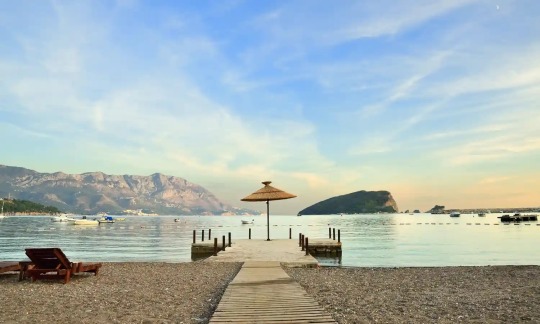
Budva. Photograph: Kuriyama Chikara/Getty Images
Heading north, sights include the mountain-top mausoleum of 19th-century ruler Petar II Petrović-Njegoš; Cetinje, the former capital; and the Ostrog Monastery, built into a cliff. Durmitor national park, with its forests, lakes and mountains, is the ultimate destination for outdoor adventure. Zabljak, highest town in the Balkans (1,456 metres), is a good base. Visitors can zipline across the 1.3km-deep Tara Canyon; go white-water rafting on the Tara river; swim in the Black Lake; or brave wolves and bears as they hike 25 marked trails.
Kosovo

Mirusha waterfalls are in a protected park in central Kosovo known for its canyons and karst landscape. Photograph: Olivier Wullen/Alamy
Kosovo declared independence from Serbia in 2008 and remains a largely undiscovered tourist destination for Britons, who perhaps still associate it with the year-long war in 1998. But today it is a safe place to travel, with few crowds and low prices. Landlocked Kosovo comprises two major plains surrounded by mountains with 50 peaks over 2,000 metres. That means great hiking, horse riding and skiing. With no sea, swimming in natural pools is popular: the Mirusha Waterfalls have canyons, caves and 13 lakes. There is a lively nightlife scene in Pristina, the capital, and in the second city Prizren. It’s partly thanks to this Balkan state having the youngest population in Europe – more than 65% of people are under 30. The two cities also have many mosques, museums and monuments, including Pristina’s Emin Gjiku ethnographic museum and the Newborn monument, unveiled for independence and painted in a different style every year.
Elsewhere, top sights include four Unesco-listed monasteries and churches – Dečani, Peć, Gračanica and Ljeviš; the Bear Sanctuary, home to European brown bears rescued from captivity by the charity Four Paws; and Gadime Cave, full of crystallised stalagmites and stalactites.
Slovenia

Ljubljana is a city of baroque and Habsburg buildings. Photograph: kasto80/Getty Images
Slovenia has a charming capital city; mountains, lakes and forests; fine wines; and even a short stretch of coastline. Ljubljana, the compact capital, is built around the river Ljubljanica, with baroque and Habsburg buildings on both banks. A glass of wine on a riverside terrace is hard to beat, but the city also has a hilltop castle, art galleries, theatres and museums (featuring Europe’s only complete mammoth skeleton at the Museum of Natural History), iconic 20th-century architecture by Slovene Jože Plečnik, and wooded Tivoli Park.
Piran is the loveliest town on the Slovenian coast, with Italianate architecture reflecting centuries of Venetian rule
In the north-west of the country, the top sights are the spectacular Lakes Bled and Bohinj in the Julian Alps. On the other side of the mountains, the less-visited Soča Valley offers hiking, rafting and kayaking in summer, and skiing and snowboarding in winter.
Heading south, must-visits include the Postojna and Škocjan caves, and Predjama Castle, built into a cave mouth. Piran is the postcard town on the coast, with Italianate architecture reflecting centuries of Venetian rule.
East Slovenia is wine country – lively Maribor, the second city, boasts the world’s oldest vine – and is a good choice for a farm stay. Ptuj, the oldest town in Slovenia, is a pretty place for a day trip.
Bosnia and Herzegovina

Hikers in the Sutjeska national park. Photograph: Witold Skrypczak/Alamy
Another country associated with 1990s warfare, Bosnia and Herzegovina is back on the backpacker trail. The capital, Sarajevo, has been likened to a miniature Istanbul or Jerusalem, with its old town, Baščaršija, full of bazaars, mosques and restaurants. But recent history hasn’t been forgotten: the Historical Museum and Tunnel Museum both tell the story of the four-year siege that killed 10,000 people in the 1990s.
Mostar, in the south, is the second-biggest draw, famed for its beautiful Old Bridge – visitors can pay to dive off it if they dare. Less touristy (and longer) is Arslanagić Bridge in the pretty town of Trebinje in the far south-west. Other notable towns include Travnik, the former Ottoman capital, and Jajce, with a spectacular waterfall.
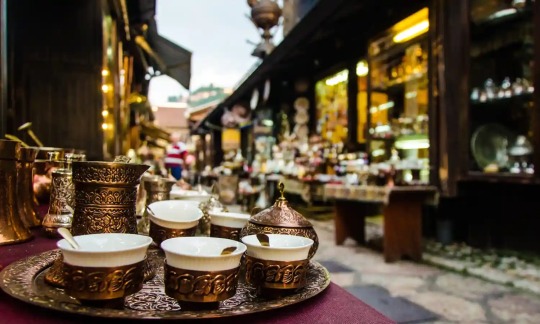
Baščaršija, Sarajevo’s old town. Photograph: Federica Gentile/Getty Images
White-water rafting is popular from March to October; one of the best rafting regions is around the town of Bihać, handy for the rapids of the Una river. Other active options include multi-day hikes in the Sutjeska national park, overnighting in mountain huts, and the 10-day TransDinarica mountain biking trail from Mostar to Sarajevo. Riders stay in B&Bs and homestays and eat homegrown food. In winter, there is affordable skiing in the Bjelašnica and Jahorina mountains south of Sarajevo.
North Macedonia

North Macedonia is blessed with lakes. Photograph: AleksandarGeorgiev/Getty Images
North Macedonia – so-called since 2019 – is a mountainous but green Balkan state. While it may be landlocked, it is blessed with lakes: most famously Ohrid, one of Europe’s oldest and deepest, but also Prespa, Dojran and more than 50 smaller glacial lakes.
Unesco-listed Lake Ohrid is the top attraction, surrounded by ancient monasteries, beach bars and seafood restaurants. Activities include lakeside cooking classes, e-biking, boat trips and paragliding. The town of the same name is full of churches and monuments, and dotted along the lake are picturesque fishing villages.
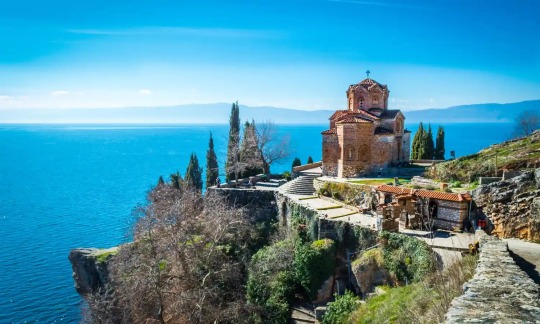
Church of St John at Kaneo, Lake Ohrid. Photograph: Saraginov/Getty Images
Skopje, the capital, is less immediately appealing, but retains a Byzantine fort and an Ottoman centre, plus modern additions such as the Museum of Contemporary Art. Mavrovo national park, on another lake and home to bears, wolves and lynx, offers hiking, biking, horse riding and swimming in the summer, and skiing in the winter. It’s also home to the picturesque, 11th-century Sveti Jovan Bigorski monastery. The other national parks are Galičica, found between lakes Ohrid and Prespa, and Pelister, a mountain with two glacial lakes.
4 notes
·
View notes
Text

Link to previous posts.
Crafted between 1150 and 1200 CE, the Lewis Chessmen were discovered in a dry-stone chamber buried inside a sand dune on the Scottish island of Lewis. The island was under Scandinavian control from the 9th century until 1266, when it was ceded to Scotland by the Treaty of Perth. (What about its neighbouring islands?)
Figures from the upper levels of most European medieval societies are depicted amongst the collection, including 'beserkers', the Viking soldiers who would work themselves up into a frenzy (hence the word 'beserk') and rush into combat virtually unprotected by armour. The pieces are from several incomplete sets: there are eight kings and queens, 15 knights, 12 rooks and 19 pawns. Fourteen pieces are plain round tokens which may have been from another board game called hnefatafl. Some pieces were originally stained red.
Chess originated in India around 500 CE, spread westwards to Persia and, by the mid-7th century, throughout the Islamic world. The rules gradually changed and the Indian war elephant was replaced by a Bishop. By the 11th century the game had gained popularity with the European aristocracy. That Viking chieftains in the Scottish Highlands were seemingly also participating in the game is a sign of their gradual integration into mainstream European feudal culture.
Hurriedly cobbled together from pages 126-7 in History of the World in 1,000 Objects, published by Dorling Kindersley.
3 notes
·
View notes
Text
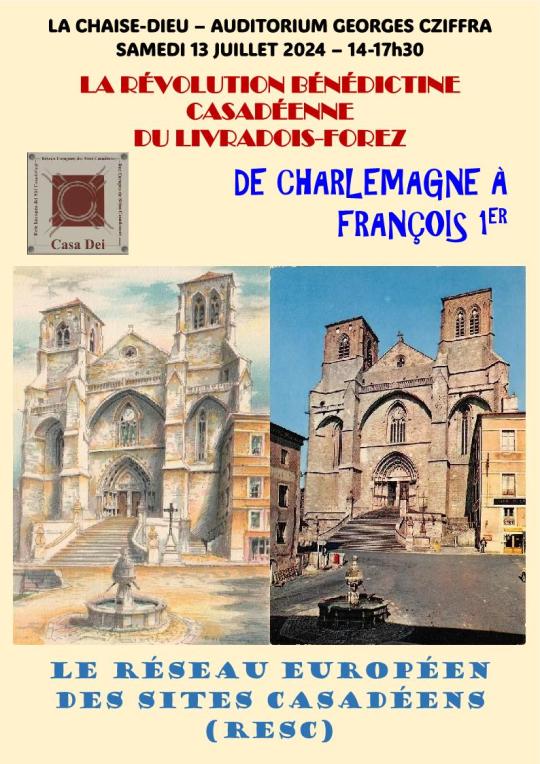
LA CHAISE-DIEU MÉDIÉVALE & LA RÉVOLUTION BÉNÉDICTINE
On July 13, 2024, at La Chaise-Dieu, the European Network of Casadean Sites will present a public conference on the topic of the Benedictine Revolution in Livradois-Forez, led by the La Chaise-Dieu Abbaye, starting a bit earlier with the religious reform brought up by Charlemagne in the 9th century. The Abbaye was founded less than 200 years later. The conference will focus the discussion – and it has to be a discussion – on the consequences of the Carolingian religious reform, the agricultural revolution with the invention of the horse collar and the management of the land, the rotation of crops, cultivation, and fertilization. Then the proto-industrial revolution that will bring five types of watermills for grain, oil, tan, hemp (fiber and cloth), and slightly later paper. This will make Livradois-Forez an essential region producing hemp cables and hemp cloth for ships. The first result was 75 days without any work in the year, no work before and after morning and evening angelus, and a pause with midday angelus. The second result was better food and demographical expansion, up to the end of the 13th century.
Then things became darker. Overpopulation brought unrest and all sorts of contests and conflicts at the religious level itself (Crusades in the Middle East, but also against the Cathars in France. Then in 1346, the Black Death, a pandemic in Europe of the bubonic plague, caused a tremendous level of deaths. Then, the One Hundred Years War started in 1337. The resilience of the population enabled Europe in general to go through, and around 1450 the printing press was developed by Gutenberg enabling the printing of books for the highly-needed university training of great numbers of people to bring Europe back on its feet. The Renaissance was the result of this period, a tremendously positive and creative period, and at the same time, a highly-disturbed era with The Reformation, and the religious wars that concerned all countries at a time when nationalism was emerging.
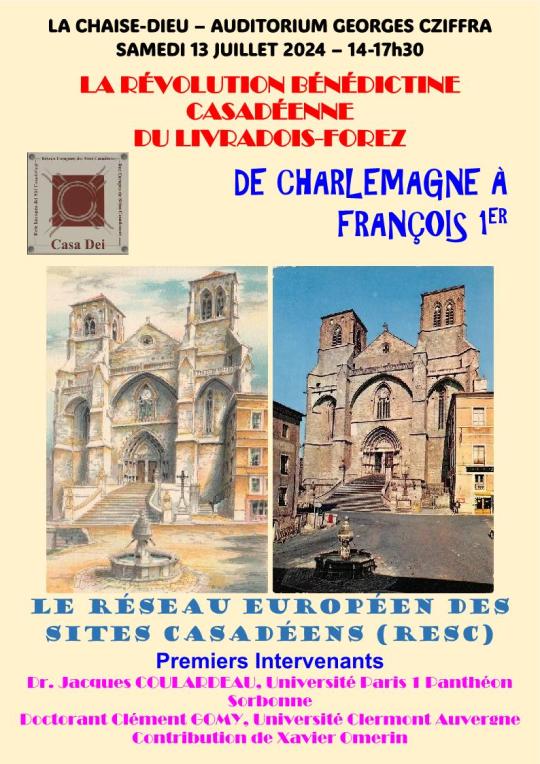
Two speakers-debaters will present the five or six centuries concerned as fast as possible to let the audience debate questions like:
1- The influence and impact of Charlemagne’s religious reform.
2- The feudal system: land ownership and serfdom.
3- The role of technology to produce energy, replace human work, and develop new products.
4- Religious tensions with Avignon and Rome conformist Popes.
5- The role of The Inquisition and religious justice.
6- The fate of the cable industry when Omerin In Ambert is number one in Europe or the world for various high-security and high-technicity cables.
7- The culture: architecture, music, painting, carving, theater, oratorio and opera, literature.
It will take place at LA CHAISE-DIEU – AUDITORIUM GEORGES CZIFFRA
SAMEDI 13 JUILLET 2024 – 14-17 HEURES 30.
The two main speakers so far are Dr Jacques COULARDEAU (Université Paris 1 Panthéon-Sorbonne) and PhD Graduate Student Clément GOMY (Université Clermont Auvergne) with a direct contribution by Ludivine BOURDUGE and Xavier OMERIN on the adventure of the Omerin Family.
Make it a day visit with the Abbey church to visit, the choir tapestries in their new shrine, Lavaudieu’s Abbey church of the female branch of the order, and climbing to the top of what they call in La Chaise-Dieu the scaffoldings of the abbey church. You may also come across Saint Robert de Turlande in the cloister if you can meditate on and contemplate twelve centuries of human history in this heart of spirituality.
2024, Éditions La Dondaine, Medium.com
28 Pages
Feudalism and Lordship, * Charlemagne, * Middle Ages, * Catholic Church, * History of Serfdom
MEDIEVAL LA CHAISE-DIEU & THE BENEDICTINE REVOLUTION
Le 13 juillet 2024, à La Chaise-Dieu, le Réseau Européen des Sites Casadéens présentera une conférence publique sur le thème de la Révolution Bénédictine en Livradois-Forez, structurée par l'abbaye de La Chaise-Dieu, bien qu’elle eût commencé un peu plus tôt par la réforme religieuse élaborée par Charlemagne au 9ème siècle. L'Abbaye a été fondée moins de 200 ans plus tard. La conférence orientera la discussion – et cela doit être une vraie discussion – sur les conséquences de la réforme religieuse carolingienne, la révolution agricole avec l'invention du collier de cheval et la gestion des terres, la rotation des cultures, les méthodes agraires et la fertilisation. Puis la révolution proto-industrielle qui apportera cinq types de moulins à eau pour les céréales, l'huile, le tan, le chanvre (fibre et toile) et, un peu plus tard, le papier. Le Livradois-Forez deviendra ainsi une région incontournable pour la production de câbles et de toiles de chanvre pour la marine, marchande en un premier temps et royale au 17ème siècle. Le premier résultat a été 75 jours sans aucun travail dans l'année, aucun travail avant et après l'angélus du matin et du soir, et une pause avec l'angélus de midi. Le deuxième résultat fut une meilleure alimentation et une expansion démographique, jusqu'à la fin du 13ème siècle.
Puis les choses sont devenues plus sombres. La surpopulation a provoqué des troubles et toutes sortes de luttes et de conflits au niveau religieux lui-même (croisades au Moyen-Orient, mais aussi contre les Cathares en France). Puis en 1346, la peste noire, une pandémie de peste bubonique en Europe, a provoqué un terrible désastre. Puis, la guerre de Cent Ans éclata en 1337 et dura 120 ans. La résilience de la population permit à l'Europe en général de s'en sortir et vers 1450 l'imprimerie fut développée par Gutenberg permettant l'impression de livres pour les formations universitaires indispensables et l’éducation d'un grand nombre de personnes pour remettre l'Europe sur pied. La Renaissance est le résultat de cette période, une période extrêmement positive et créatrice, et en même temps, une époque très perturbée avec la Réforme Protestante et les guerres de religion qui ont concernée. tous les pays à une époque où le nationalisme émergeait.

Deux intervenants-débatteurs présenteront succinctement les cinq ou six siècles concernés pour permettre au public de débattre de questions telles que :
1- L’influence et l’impact de la réforme religieuse de Charlemagne.
2- Le système féodal : propriété foncière et servage.
3- Le rôle de la technologie pour produire de l'énergie, remplacer le travail humain et développer de nouveaux produits.
4- Tensions religieuses avec les papes conformistes d'Avignon et de Rome.
5- Le rôle de l'Inquisition et de la justice religieuse.
6- Le sort de l'industrie du câble, alors qu'Omerin à Ambert est numéro un en Europe ou dans le monde pour divers câbles de haute sécurité et de haute technicité.
7- La culture : architecture, musique, peinture, sculpture, théâtre, oratorio et opéra, littérature.
Elle aura lieu à LA CHAISE-DIEU – AUDITORIUM GEORGES CZIFFRA
SAMEDI 13 JUILLET 2024 – 14-17 HEURES 30.
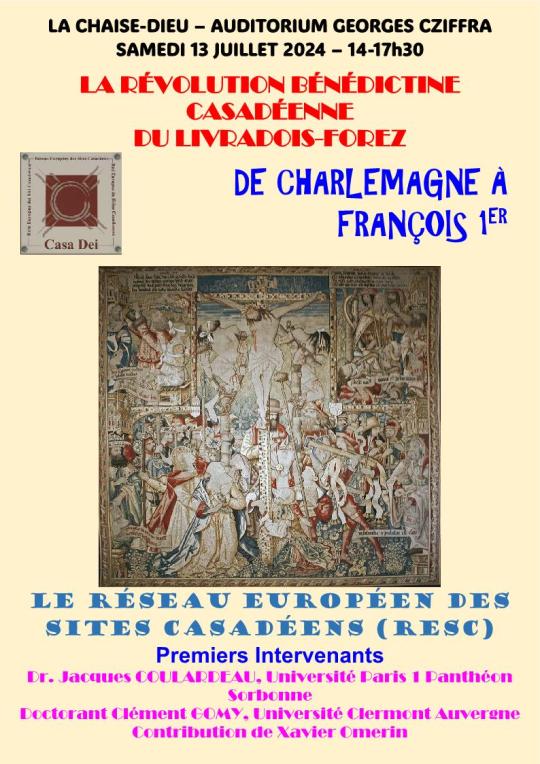
Les deux principaux intervenants sont pour le moment le Docteur Jacques COULARDEAU (Université Paris 1 Panthéon-Sorbonne) et le Doctorant Clément GOMY (Université Clermont Auvergne) avec une contribution de Ludivine BOURDUGE et Xavier OMERIN sur l’aventure de la Famille Omerin.
Faites-en une journée complète de visite avec l'église abbatiale qui vaut un coup d’œil, les tapisseries du chœur dans leur nouvelle châsse architecturale qui valent un deuxième coup d’œil, l'église abbatiale de Lavaudieu de la branche féminine de l'ordre, et la montée au sommet de ce qu'on appelle à La Chaise-Dieu l‘échafaudage de l'église abbatiale avec un casse-croûte tout en haut. Vous pourrez également croiser Saint Robert de Turlande dans le cloître si vous avez la patience de méditer et contempler douze siècles d'histoire humaine dans ce cœur vivant de spiritualité.
2024, Éditions La Dondaine, Medium.com
28 Pages
Feudalism and Lordship, * Charlemagne, * Middle Ages, * Catholic Church, * History of Serfdom
0 notes
Text
10 of the best museums to visit in London city
1. British Museum: Housing over 8 million artifacts spanning human history and civilizations, the British Museum is a must-visit for any history buff. Explore ancient Egyptian mummies, marvel at the Rosetta Stone, and admire the Parthenon sculptures. Don't miss the interactive exhibits and special displays that bring the past to life.
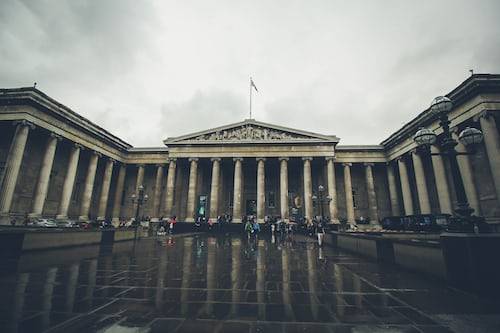
2. Natural History Museum: Step into a world of wonder at the Natural History Museum, home to iconic dinosaur skeletons like Dippy the Diplodocus and Hintze the Blue Whale. Wander through galleries showcasing the diversity of life on Earth, from the tiniest insects to the mightiest mammals. Be sure to check out the Darwin Centre, where you can learn about evolution and human origins.
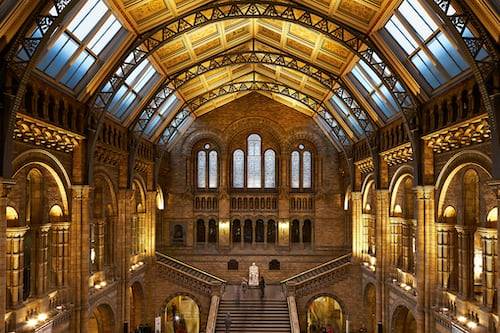
3. Victoria and Albert Museum (V&A): Immerse yourself in the world of art and design at the V&A. This stunning museum boasts a vast collection spanning fashion, furniture, ceramics, jewelry, and more. From medieval tapestries to contemporary fashion installations, the V&A offers a visual feast for all. And if you're feeling inspired, why not book a pair of London split train tickets and explore the vibrant city that birthed so many of these artistic treasures? Whether you're a history buff, a fashion enthusiast, or simply someone who appreciates beautiful things, the V&A is a must-visit destination.
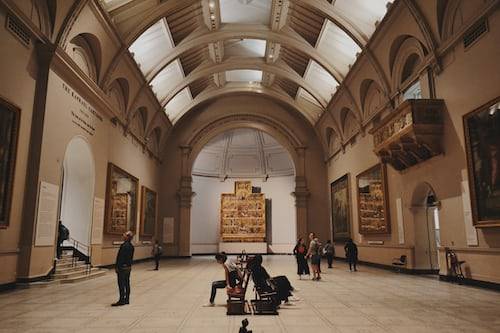
4. National Gallery: Art lovers, rejoice! The National Gallery houses an unparalleled collection of Western European paintings from the 13th to the 19th centuries. Gaze in awe at masterpieces by Van Gogh, Monet, Da Vinci, and many more. With free entry and themed walking tours, the National Gallery is a haven for art enthusiasts.

5. Science Museum: Ignite your inner scientist at the Science Museum, where interactive exhibits make learning fun and engaging. Explore space exploration, delve into the mysteries of the human body, and witness groundbreaking inventions from throughout history. Don't miss the iconic IMAX cinema, showcasing awe-inspiring documentaries on the big screen.

6. Churchill War Rooms: Step back in time and experience the drama of World War II at the Churchill War Rooms. Explore the underground bunker where Britain's wartime Prime Minister, Winston Churchill, and his staff planned the Allied victory. Original maps, telephones, and artifacts bring history to life, while immersive audio recordings make you feel like you're right there in the thick of the action.

7. Tate Modern: Immerse yourself in the world of modern and contemporary art at Tate Modern. Housed in a former power station, this iconic museum showcases works by Picasso, Matisse, Kandinsky, and other artistic giants. Don't miss the free Turbine Hall exhibits, featuring ever-changing installations by renowned artists. And to avoid the queues, remember to split train tickets – purchase one for your outward journey and a separate one for your return trip. This can often be cheaper and save you valuable time waiting in line!

8. The Tower of London: Journey through history and intrigue at the Tower of London, a UNESCO World Heritage Site. Explore the medieval fortress, marvel at the Crown Jewels, and learn about the dark and fascinating stories of the Tower's past. Be sure to join a guided tour for the inside scoop on executions, ghosts, and royal secrets.

9. Sherlock Holmes Museum: Calling all armchair detectives! Step into the world of fiction at the Sherlock Holmes Museum, located at 221B Baker Street. Explore the iconic detective's Victorian-era house, admire his gadgets and disguises, and meet Mrs. Hudson and Dr. Watson. Interactive exhibits and costumed actors bring the stories to life, making you feel like you've stepped into a Conan Doyle novel.
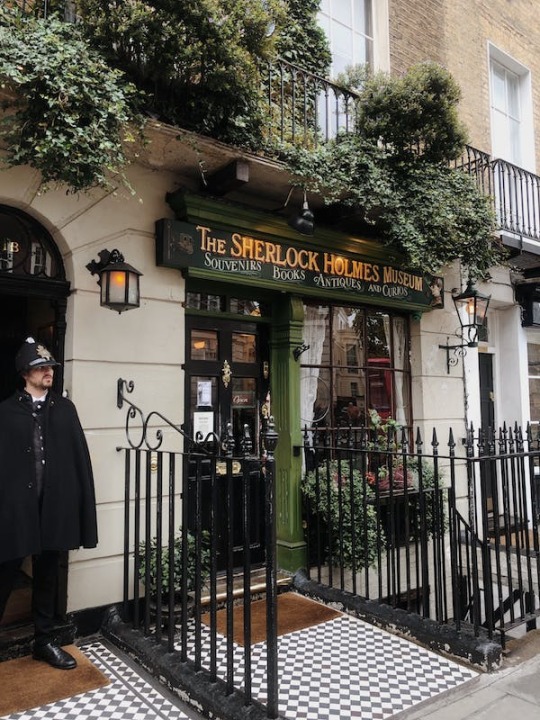
10. London Transport Museum: Take a nostalgic journey through London's transportation history at the London Transport Museum. Discover vintage buses, iconic red double-deckers, and even an original Tube carriage. Learn about the city's changing transport landscape, from horse-drawn carriages to the modern Underground. Interactive exhibits and hands-on activities make this a fun and educational experience for all ages.

This is just a glimpse into the wealth of museums that London has to offer. With its diverse collections, engaging exhibits, and historical significance, these 10 museums are sure to leave you inspired and informed. So pack your curiosity, lace up your walking shoes, and prepare to be amazed by the treasures that await you in London's museum wonderland!
0 notes
Text
European War 7 v2.3.2 MOD APK (Unlimited Money/Unlock All Characters) https://apkpic.com/wp-content/uploads/2023/10/european-war-7-medieval.png https://apkpic.com/en/european-war-7-medieval-Mod-apk?feed_id=12940&_unique_id=659aaa99ef95d
0 notes
Text
An excellent book but with one deep flaw:
This book has but one main defect, but unfortunately a very serious one in that it reads history backwards. Because the future of India held the Raj and the India Company and all that came with both, the Mughals, who could not have foreseen such a future and whose goals were very different, were blamed for not having the foresight as early modern gunpowder monarchs for not acting in the eyes of post-colonial reformism.
Not a single one of the Mughal Emperors charted here from Babur to Aurangzeb visualized a world like that. They were products of the evolution of medieval to modern Islam, products of the gunpowder age, and viewed themselves as imperial overlords of Hindustan but not ones that operated on unfamiliar context like a unified Indian subcontinent against what were then minor ticks dug into India's side.
This shapes both the understandings of the various wars and the various deeds, which are appraised in 'how well would this have stood up to the European-controlled future' rather than being understood as things in themselves. This creates some massive distortion effects with understanding Din-i-Ilahi and the impact of the Dara Shikoh-Aurangzeb War. Dara might have been the nicer, more humane person but in a political system reliant on getting there firstest with the mostest if he failed that simple task, was he really a good, or effective, Emperor? Or aspiring Emperor? Should Dara be judged by the might have beens that he in all probability wouldn't have lived up to anyway because he was no more a man capable of foreseeing a Clive future than Aurangzeb? Or by the standard of the world Dara was actually from?
It also, further, affects and afflicts the understanding of the Mughal Empire's changes from a raiding state of the northern Indian-Afghan region to a subcontinental empire. For all of these faults it is excellently written and provides a detailed look at the great Muslim empire that at its heyday was the richest, most powerful state in the world and the start of the fall under Aurangzeb.
7/10.
0 notes